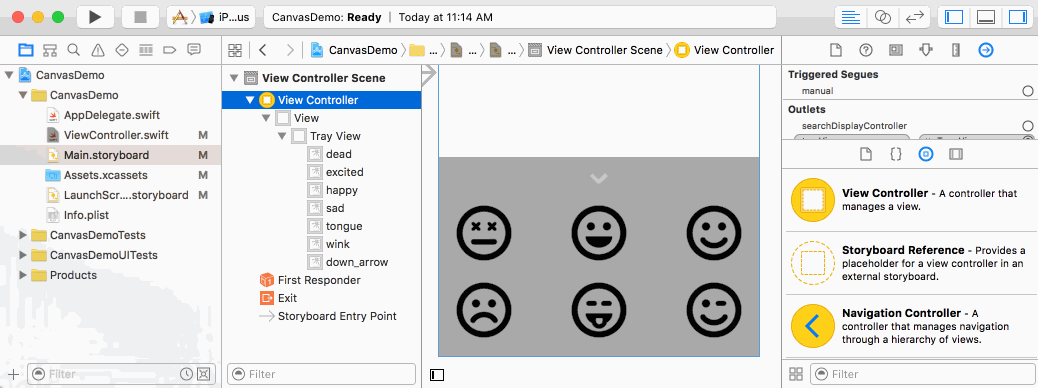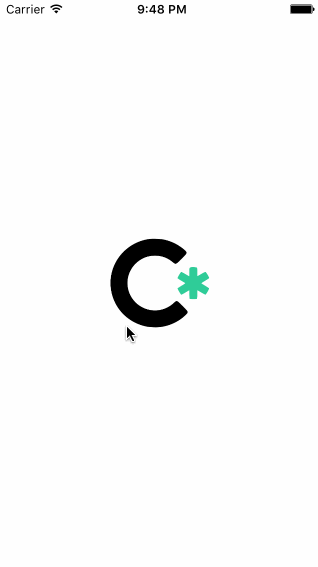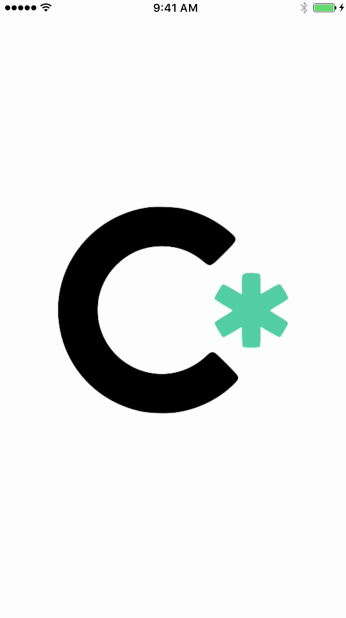Gesture recognizers are a powerful and easy to use tool for handling user gestures like tap or pinch and performing actions like triggering animations or view changes. This is a quick guide for the steps in setting up gesture recognizers.
There are many builtin gesture recognizers in iOS, and you can also create your own. Choose one from the following list.
UITapGestureRecognizer: Can be configured with the number of required taps to handle single, double, or more taps.
UILongPressGestureRecognizer: Can be configured with the required delay to be considered a long press. Defaults to 0.5 s.
UIPanGestureRecognizer
UIPinchGestureRecognizer: Used for pinch in and pinch out, this gesture recognizer continuously outputs to a scale property as the user moves their finger.
UIRotationGestureRecognizer: Continuously outputs to rotation in radians.
UIScreenEdgePanGestureRecognizer: Can be configured with which edge to detect pans from. Only detects pan movements that begin from the specified edge.
Choose a Gesture Recognizer from the Object Library based on the functionality your app needs.

Drag a Gesture recognizer from the Object Library and drop it onto the View you want the Gesture to be attached to.

Ctrl-drag from your Gesture Recognizer to the ViewController swift file to create an action. It's often easier to drag from the Gesture Recognizer in the Document Outline.

When the gesture recognizer detects the gesture, it will call the event handler method on the target. Declare the method you want called by the gesture recognizer.
Gesture recognizers call the same selector as it transitions through various states. For example, a pan gesture recognizer calls the selector when the user first touches down on the view, and then it calls the selector repeatedly as the user drags their finger across the screen, and finally it calls the selector one last time when the user lifts their finger off the screen.
func didTap(sender: UITapGestureRecognizer) {
let location = sender.location(in: view)
// User tapped at the point above. Do something with that if you want.
}- (IBAction)didTap:(UITapGestureRecognizer *)sender {
CGPoint location = [sender locationInView:self.view];
// User tapped at the point above. Do something with that if you want.
}func didPan(sender: UIPanGestureRecognizer) {
let location = sender.location(in: view)
let velocity = sender.velocity(in: view)
let translation = sender.translation(in: view)
if sender.state == .began {
print("Gesture began")
} else if sender.state == .changed {
print("Gesture is changing")
} else if sender.state == .ended {
print("Gesture ended")
}
}func didPinch(sender: UIPinchGestureRecognizer) {
// get the scale value from the pinch gesture recognizer
let scale = sender.scale
}func didScreenEdgePan(sender: UIScreenEdgePanGestureRecognizer) {
// Do something when the user does a screen edge pan.
}It is common to create the gesture recognizers in the viewDidLoad() method, as shown below. After you create the gesture recognizer, attach it to the view you want to detect gestures on.
// The didTap: method will be defined in Step 3 below.
let tapGestureRecognizer = UITapGestureRecognizer(target: self, action: #selector(didTap(sender:)))
// Optionally set the number of required taps, e.g., 2 for a double click
tapGestureRecognizer.numberOfTapsRequired = 2
// Attach it to a view of your choice. If it's a UIImageView, remember to enable user interaction
yourView.isUserInteractionEnabled = true
yourView.addGestureRecognizer(tapGestureRecognizer) // Here we use the method didPan(sender:), which we defined in the previous step, as the action.
UITapGestureRecognizer *tapGestureRecognizer = [[UITapGestureRecognizer alloc] initWithTarget:self action:@selector(didTap:)];
// Optionally set the number of required taps, e.g., 2 for a double click
tapGestureRecognizer.numberOfTapsRequired = 2;
// Attach it to a view of your choice. If it's a UIImageView, remember to enable user interaction
[self.view setUserInteractionEnabled:YES];
[self.view addGestureRecognizer:tapGestureRecognizer]; // Here we use the method didPan(sender:), which we defined in the previous step, as the action.
let panGestureRecognizer = UIPanGestureRecognizer(target: self, action: #selector(didPan(sender:)))
// Attach it to a view of your choice. If it's a UIImageView, remember to enable user interaction
yourView.isUserInteractionEnabled = true
yourView.addGestureRecognizer(panGestureRecognizer)// Instantiate and initialize the screen edge pan gesture recognizer
let screenEdgePanGestureRecognizer = UIScreenEdgePanGestureRecognizer(target: self, action: #selector(didScreenEdgePan(sender:)))
// Configure the screen edges you want to detect.
screenEdgePanGestureRecognizer.edges = UIRectEdge.left
// Attach the screen edge pan gesture recognizer to some view.
yourView.isUserInteractionEnabled = true
yourView.addGestureRecognizer(screenEdgePanGestureRecognizer)let location = sender.location(in: view)CGPoint location = [sender locationInView:self.view]; let location = sender.location(in: view)
let translation = sender.translation(in: view)
let velocity = sender.velocity(in: view)var scale = sender.scale
var velocity = sender.velocityvar rotation = sender.rotation
var velocity = sender.velocityBelow are some common tasks that you might have with gesture recognizers.
By default, it won't work if you add multiple gesture recognizers to the same view. In order to do that, you have to specifically enable it.
For example, if you want to use a pinch and rotate gesture recognizer simultaneously, choose either the pinch or the rotate gesture recognizer (it doesn't matter which one). If you created the gesture recognizer in Interface Builder, create an IBOutlet for it by Ctrl-dragging from the nib.
pinchGestureRecognizer.delegate = self
Go to the header file of the view controller and add UIGestureRecognizerDelegate to the list of protocols, as shown below.
class MainViewController : UIViewController, UIGestureRecognizerDelegate
...
@end
Implement the following UIGestureRecognizerDelegate method in your Swift file.
func gestureRecognizer(gestureRecognizer: UIGestureRecognizer, shouldRecognizeSimultaneouslyWithGestureRecognizer otherGestureRecognizer: UIGestureRecognizer) -> Bool {
return true
}Now the pinch and scale gesture recognizers should work simultaneously.

Slide out trays, Hamburger menus, and any other view you want to move by sliding your finger can be configured using a UIPanGesture Recognizer.
The following steps describe the process of creating a vertically sliding Tray. If you would like to make a Hamburger style horizontally sliding View, use the same concepts described below, but use the x-components of the translation in place the y-components. If you want a view that can be panned in all directions, use both x and y-components of the translation.
trayView.didPanTray. You can add a Gesture Recognizer in Storyboard or add a Gesture Recognizer programmatically
Define an Instance Variable that can be accessed throughout the View Controller. We define these variables at the top of the ViewController Swift file, right above the viewDidLoad method.
var trayOriginalCenter: CGPoint!
The code to make the Tray draggable will go inside our didPanTray method.
NOTE: If you created your Gesture Recognizer and added an Action in Storyboard, the method will be proceeded by @IBAction.
@IBAction func didPanTray(sender: UIPanGestureRecognizer) {
}didPanTray method, we want to access the translation property of the UIPanGestureRecognizer and store it in a variable. This will tell us how far our finger has moved from the original "touch-down" point as we drag. We will also print the translation value to the console to get a feel for what it means. You should see that the translation is a CGPoint with values for the x and y components. let translation = sender.translation(in: view)
print("translation \(translation)").began is called once at the very beginning of each gesture recognition..changed is called continuously as the user is in the process of "gesturing"..ended is called once at the end of the gesture.if sender.state == .began {
} else if sender.state == .changed {
} else if sender.state == .ended {
}When the gesture begins (.began), store the tray's center into the trayOriginalCenter variable:
trayOriginalCenter = trayView.centerAs the user pans (.changed), change the trayView.center by the translation. Note: we ignore the x translation because we only want the tray to move up and down:
trayView.center = CGPoint(x: trayOriginalCenter.x, y: trayOriginalCenter.y + translation.y)
When a user stops panning the Tray, we want the tray to animate to an up or down position. We will infer that if the users last gesture movement was downward, they intend to close the tray to it's down position. Conversely, if they are NOT panning down, they must be panning up, and intend to open the tray to it's up position.
We can tell which way a user is panning by looking at the gesture property, velocity. Like translation, velocity has a value for both x and y components. If the y component of the velocity is a positive value, the user is panning down. If the y component is negative, the user is panning up.
Since we are focusing on the user's last gesture movement, we will check for the velocity in the .ended condition of our gesture state conditional statement.
let velocity = sender.velocity(in: view). Pan Gesture Recognizer
var trayDownOffset: CGFloat!
var trayUp: CGPoint!
var trayDown: CGPoint!viewDidLoad method, assign values to the trayDownOffset, trayUp and trayDown variables . The trayDownOffset will dictate how much the tray moves down. 160 worked for my tray, but you will have to adjust this value to accommodate the specific size of your tray. trayDownOffset = 160
trayUp = trayView.center
trayDown = CGPoint(x: trayView.center.x ,y: trayView.center.y + trayDownOffset)didPanTray(_:) method, within the gesture state, .ended, create a conditional statement to check the y component of the velocity. In the case that the tray is moving down, animate the tray position to the trayDown point, otherwise, animate it towards the trayUp point. Animating View Properties
if velocity.y > 0 {
UIView.animate(withDuration: 0.3) {
trayView.center = trayDown
}
} else {
UIView.animate(withDuration: 0.3) {
trayView.center = trayUp
}
}This Use-Case will explore using multiple gesture recognizers simultaneously to scale and rotate an ImageView.

didPinch and didRotate. You can add a Gesture Recognizer in Storyboard or add a Gesture Recognizer programmatically
Since we will be using multiple gesture recognizers at the same time, we will need to configure our ViewController to support Simultaneous Gesture Recognizers.

Within the didPinch method...
sender.view returns a generic UIView so we need to specify that we are working with a UIImageView using as! UIImageView.CGAffineTransformScale instead of CGAffineTransformMakeScale. This is because CGAffineTransformScale allows us to add to the previous transform state as an argument, previousTransfrom whereas CGAffineTransformMakeScale will overwrite it completely. Combining Transforms
previousTransform each time the method is called. If we didn't reset the scale, each time around the scale that was added to the previousTransform would be doubled and our Image View would scale out of control! But don't take my word for it, run the app without resetting the scale back to 1 and see what happens! @IBAction func didPinch(sender: UIPinchGestureRecognizer) {
let scale = sender.scale
let imageView = sender.view as! UIImageView
imageView.transform = CGAffineTransformScale(imageView.transform, scale, scale)
sender.scale = 1
}
Within the didRotate method...
sender.view returns a generic UIView so we need to specify that we are working with a UIImageView using as! UIImageView.CGAffineTransformRotate instead of CGAffineTransformMakeRotate for the same reasons we chose our scale transform method. Combining Transforms
@IBAction func didRotate(sender: UIRotationGestureRecognizer) {
let rotation = sender.rotation
let imageView = sender.view as! UIImageView
imageView.transform = CGAffineTransformRotate(imageView.transform, rotation)
sender.rotation = 0
}